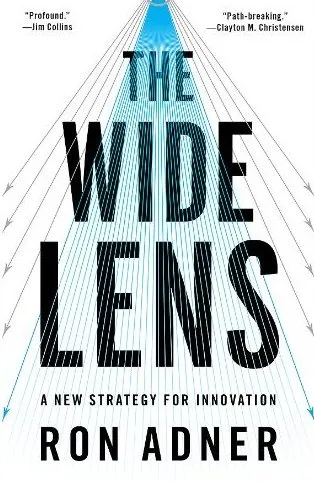The Wide Lens: What successful innovators see that others miss

This is an insightful book on the importance of having a ‘wide lens’ view for companies to innovate not just internally but in the entire value-chain ecosystem connecting them to their end customers.Many books address ideation, testing prototypes and brand design – but few address the importance of the whole network of actors who collectively deliver innovations to the market.
Ron Adner (@RonAdner) is professor of strategy at the Tuck School of Business at Dartmouth College. He was previously at INSEAD, and is a consultant to companies around the world. His writing has appeared in The Wall Street Journal, the Financial Times, Forbes, and the Harvard Business Review.
“Over the past two decades we have witnessed a systematic shift away from independent success,” begins Adner. The success of innovation depends not just on internal creativity and execution but on the ability, willingness and likelihood that a company’s inter-dependent value-chain partners succeed as well.
Companies that did not orchestrate the ecosystem
The author provides a range of case studies of companies who did not successfully align the activities of players in their ecosystem. Philips pioneered HDTV in the 1980s, but high-definition cameras and content came only 20 years later; the premature launch led to a $2.5 billion write-down. Sony created an e-reader but did not have an ecosystem in place to let readers easily download e-content (DRM and publisher content). Johnson Controls developed energy-saving switches and sensors but did not adequately factor in training of architects and electricians.
Michelin developed a new kind of ‘run even when flat’ tyre – but failed to bring dealers and service garages on board the programme, which was eventually written off as a failure shortly after a costly rollout.
Nokia pioneered the 3G phone. “It won its race, but missed its goal,” explains Adner; the 6650 phone was like a “Ferrari in a world without roads.” Nokia did not successfully orchestrate the rest of the 3G content and services ecosystem which included DRM, customer analytics, digital content and conversion software (eg. from TV to mobile).
A range of pharma companies rolled out ‘inhalable insulin’ products, and got support from regulators, sales forces and doctors – but forgot to factor in the endocrinologist who did lung function tests, thus hampering product takeoff.
The dream of the electric car has faced flaws in terms of battery life, re-sale value, availability of convenient charging spots while away from home, and power grid loads during peak charging hours.
Companies that have succeeded
Today's exemplar firms do much more than "just" execute flawlessly on their own initiatives and have become masters of ecosystem strategy: such firms include Apple in consumer electronics, Amazon in retail, Roche in pharmaceuticals, Raytheon in defense, Hasbro in toys and Turner in construction. “They orchestrate the activities of an array of partners so that their joint efforts increase the value created by their own initiatives many times over,” explains Turner.
As compared to Sony’s e-reader project, Amazon’s Kindle worked much better: it created a content inventory, put in place DRM features, and made it easy for readers to download content and pay for it.
US movie studios successfully pushed through the use of digital projectors and prints in theatres not just through adopting technology standards but creating an innovative financial network (‘virtual print fee’) and new third-party digital theatre integrators (Digital Cinema Implementation Partners).
Electronic Health Records began to finally work in the public health system in the US only after decades of work, thanks to the government passing the Health IT act in 2009; mere availability of technology and standards was not enough to bring government hospitals and doctors aboard.
Korean companies like SaeHan were early in the portable mp3 player gamer, as well as Diamond’s Rio player, Compaq’s Personal Jukebox, Creative’s Nomad, and Sensory Science’s Rave. But the iPod won the game three years later, thanks to widely available broadband and mp3 collections, a simple device, music industry’s acceptance of Apple’s paid model, and iTunes music management and purchase software. Apple has shown good insights to ‘surf’ the co-innovation wave, Adner analyses.
Risk mapping and management
Based on these examples of success and failure, Adner identifies three kinds of risk for innovative companies: execution risk (bringing about innovation to the required specifications at the right time), co-innovation risk (dependence on the successful commercialisation of other innovations), and adoption chain risk (contribution of partners to adopt the innovation and enable it for end consumers).
Growing inter-dependence in the 21st century changes the strategies of scope, timing, partnership and leadership. Adner urges companies to first draw a flow map of product from company to customer, along with enabling partners in the entire ecosystem; these can be tagged as green, yellow or red, depending on their willingness and ability to be on board the programme. The innovation can succeed only when there are no ‘red’ lights in the value chain.
Adner identifies five levers of ecosystem reconfiguration in this regard: separating some elements, combining other elements, re-locating elements, adding elements, and subtracting elements.
A startup attempting this ecosystem approach for electric cars in Israel and Denmark is Shah Agassi’s Better Place. Customers and fleet managers buy the car but the company charges the batteries and rents them out; it also runs a smart-grid solution for off-peak charging. This solution works best in countries where gasoline is priced very high and there are government incentives for electric cars.
Once these elements have been identified and acted on, companies should use three guiding principles for successful ecosystems: minimum viable ecosystem, staged expansion, and ecosystem carryover (to new ecosystems).
Kenya’s m-Pesa system for mobile payment first used operator Safaricom’s agents to become cash hubs for SMS-based transactions; this ecosystem was then extended in stages to retailers, specialised ATMs, international remittances, and inclusive banking services.
Toymaker Hasbro used this approach to carryover into the moviemaking industry. Medtronic moved from pacemaker production to monitoring and diagnostic services. FedEx expanded from overnight shipping to inventory management services.
Apple’s first wave ecosystem was the iPod for Mac users rolled out through Apple stores in 2001, then carried over to other retailers, the iTunes store, and Windows users. The next ecosystem overlay was the iPhone, which first won over iPod and Mac users. Adding apps and developer platforms helped Apple re-negotiate its relationship with operators to become a senior partner – thus not just adding new customers but creating a more favourable ecosystem for Apple.
The next ecosystem carryover was the iPad, which rode the media attention wave by becoming a conduit for non-Apple content as well, thanks to eager involvement from a range of content creators and publishers around the world.
Watchful patience and monitoring the entire ecosystem with a wide lens is better than aggressive launch and hopes of first-mover advantage, Adner advises.
Cooperate, collaborate, co-create and co-innovate – that is the new mantra. “Dependence is not becoming more visible, but it is becoming more pervasive. What you don't see can kill you. Don't let your blind spot become your downfall,” cautions Adner.








![[Funding Alert] MakeMyTrip gets Rs 73.5 cr from its Mauritius entity amid coronavirus crisis](https://images.yourstory.com/cs/wordpress/2016/12/Deep-Kalra-founder-and-CEO-MakeMyTrip.jpg)


![[Startup Bharat] Y Combinator-backed BeWell Digital is enabling the digital transformation of radiologists](https://images.yourstory.com/cs/2/40d66ae0f37111eb854989d40ab39087/ImagesFrames31-1648033042143.png)